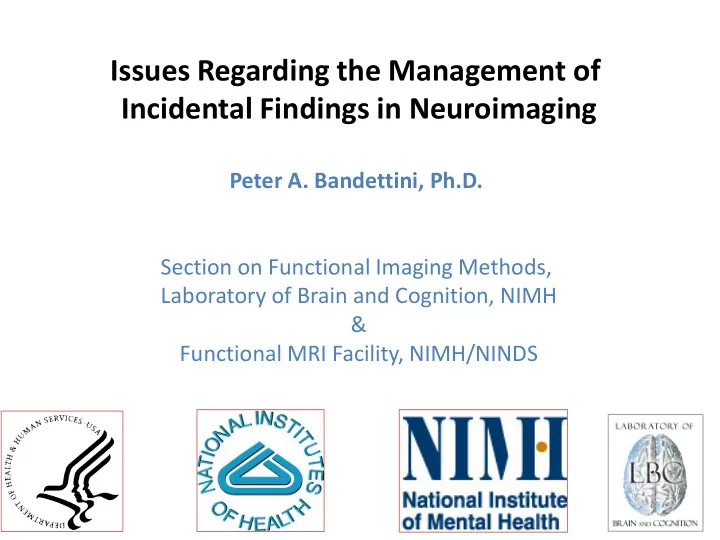

Issues Regarding the Management of Incidental Findings in Neuroimaging Peter A. Bandettini, Ph.D. Section on Functional Imaging Methods, Laboratory of Brain and Cognition, NIMH & Functional MRI Facility, NIMH/NINDS
What is the primary issue? About 2% of normal research volunteers have an incidental finding of clinical significance, and it is unknown how many truly benefit from follow-up. What should be done procedurally? What are the related issues? Active brain screening can be expensive, and has no clear benefit over treatment • following symptoms. False positives are a risk, and have deleterious impact on otherwise normal subjects. • Most research scans are not “clinical-grade” therefore difficult to interpret. • Most researchers are not qualified to read scans for diagnoses. • The prevalence of lifelong asymptomatic individuals with lesions/tumors is unknown. •
Z. Morris et al, BMJ 2009;339:b3016
R. J. Komotar, et al. Mayo Clin Proc. May 2008, 83(5): 563-565
“…researchers who obtain consent from volunteers, should provide information about the prevalence of incidental brain findings on brain MRI, the higher prevalence with high resolution MRI sequences, and the shortage of evidence to inform their management.” Z. Morris et al, BMJ 2009;339:b3016
“Brain MRI screening of asymptomatic patients regardless of age, health, or medical history is an example of an ineffective screening program that would produce many inconsequential findings and an exceedingly low rate of clinically relevant findings. Valuable screening programs must either address a highly prevalent disease or be applied to high-risk individuals, and must accurately uncover a treatable disease.” R. J. Komotar, et al. Mayo Clin Proc. May 2008, 83(5): 563-565
Possible Solutions…presented another way J. Illes, M. P. Kirschen, E. Edwards, P. Bandettini, M.K. Cho, P. J. Ford, G. H. Glover, J. Kulynych, R. Macklin, D. B. Michael, S. M. Wolf, T. Grabowski, B. Seto, Practical approaches to incidental findings in brain imaging research, Neurology, 70, 384-390 (2008).
Several Possible Solutions ? ? ? J. Illes et al.
Framing the challenge On one hand, we want to catch anything that may be significant to the health of the subject. On the other hand, what exactly would justify added cost & burden, risk of false positives?...as well as the fact that the overall effectiveness of screening is unclear. What incidence rate would justify what effort – even an effort of limited effectiveness and clear risks?
Recommend
More recommend